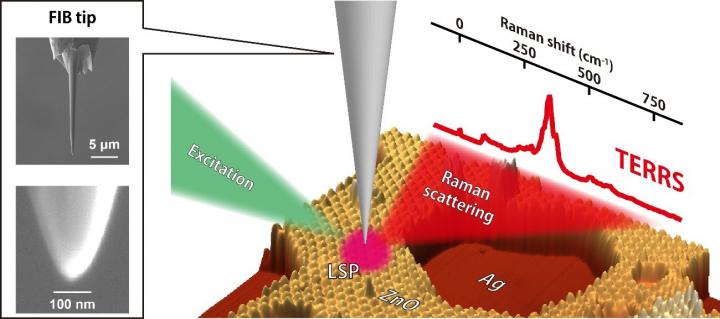'Resonance' raman spectroscopy with 1-nm resolution

Tip-enhanced resonance Raman scattering is measured by a silver tip fabricated by focused ion beam (FIB) milling. Localized surface plasmon (LSP) is excited by an excitation laser, which generates enhanced Raman scattering from ultrathin zinc oxide (ZnO) films grown on a single-crystal silver (Ag) surface. Credit: Takashi Kumagai
A research team at Fritz-Haber Institute in Berlin, headed by Dr. Takashi Kumagai, demonstrated tip-enhanced “resonance” Raman spectroscopy.
Resonance Raman spectroscopy is a powerful tool to analyze a specific chemical structure at a high sensitivity, but its spatial resolution has been restricted to be a few hundred nm due to the diffraction limit.
Extreme field confinement at a metal tip apex through localized surface plasmon excitation allows to break this limitation and now attain 1-nm resolution.
Tip-enhanced Raman spectroscopy takes advantage of atomic resolution imaging of scanning probe microscopy and enhanced Raman scattering through localized surface plasmon excitation.
The research team revealed tip-enhanced resonance Raman scattering in which both physical and chemical enhancement mechanisms are operative.
The underlying process was examined by modifying the localized surface plasmon resonance in the scanning tunneling microscope junction and by recording different-thickness zinc oxide films that exhibit a slightly different electronic structure.
In addition, the correlation between tip-enhanced resonance Raman scattering and local electronic states is resolved in combination with scanning tunneling spectroscopy that maps the local electronic state of the zinc oxide film.
The results explicitly show that a confined electromagnetic field can interact with local electronic resonances at the (sub)nanometer scale.
Media Contact
All latest news from the category: Physics and Astronomy
This area deals with the fundamental laws and building blocks of nature and how they interact, the properties and the behavior of matter, and research into space and time and their structures.
innovations-report provides in-depth reports and articles on subjects such as astrophysics, laser technologies, nuclear, quantum, particle and solid-state physics, nanotechnologies, planetary research and findings (Mars, Venus) and developments related to the Hubble Telescope.
Newest articles

Why getting in touch with our ‘gerbil brain’ could help machines listen better
Macquarie University researchers have debunked a 75-year-old theory about how humans determine where sounds are coming from, and it could unlock the secret to creating a next generation of more…

Attosecond core-level spectroscopy reveals real-time molecular dynamics
Chemical reactions are complex mechanisms. Many different dynamical processes are involved, affecting both the electrons and the nucleus of the present atoms. Very often the strongly coupled electron and nuclear…

Free-forming organelles help plants adapt to climate change
Scientists uncover how plants “see” shades of light, temperature. Plants’ ability to sense light and temperature, and their ability to adapt to climate change, hinges on free-forming structures in their…





















